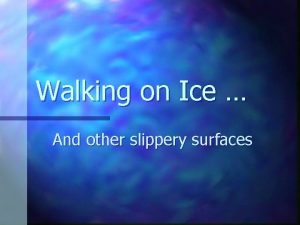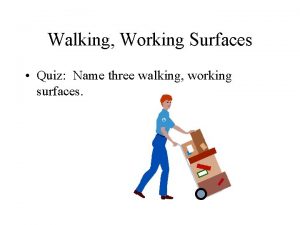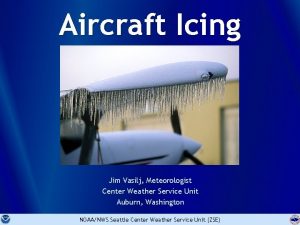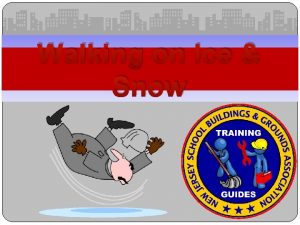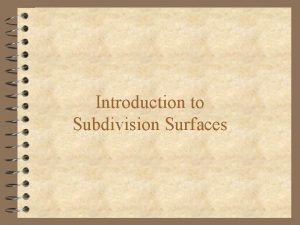Walking on Ice And other slippery surfaces Walking





















- Slides: 21

Walking on Ice … And other slippery surfaces

Walking on Ice & Snow, etc. � No matter how well the ice & snow are removed from campus streets & sidewalks, people will encounter slippery surfaces when walking outdoors in the winter.

Walking on Ice & Snow, etc. � Many coldweather injuries are the result of falls on icecovered streets and sidewalks.

Walking on Ice & Snow, etc. � Getting around on campus in icy conditions calls for planning, caution, and a little common sense.

What to Wear � Dress warmly and wear boots with nonskid soles. (Avoid plastic and leather soles. ) � Wear a bright scarf or hat or reflective gear so drivers can see you—day and night.

What to Wear � Keep warm, but make sure you can hear what’s going on around you. � Whatever you wear, make sure it doesn’t block your vision or make it hard for you to hear traffic.

What to Wear � During the day, wear sunglasses to help you see better and avoid hazards.

How to Walk � Plan ahead and give yourself enough time. � When walking on steps, always use the hand railings and plant your feet firmly on each step.

How to Walk � When walking on an icy or snow-covered walkway, take short steps and walk at a slower pace so you can react quickly to a change in traction.

How to Walk � Bending your knees a little and taking slower and shorter steps increases traction and can greatly reduce your chances of falling. � It also helps to stop occasionally to break momentum.

How to Walk � � � Approach cleared streets & sidewalks with caution. Look out for “black ice. ” Dew or water vapor can freeze on cold surfaces, forming an extra-thin, nearly invisible layer of ice that can look like a wet spot on the pavement. It can happen early in the morning or in areas shaded from the sun.

How to Walk �A heavy backpack or other load can challenge your sense of balance. � Try not to carry too much—you need to leave your hands and arms free to better balance yourself.

How to Walk � Be prepared to fall and try to avoid using your arms to break your fall. � If you fall backward, make a conscious effort to tuck your chin so your head won’t hit the ground with full force.

How to Walk � When entering a building, remove as much snow and water from your boots as you can. � Notice that floors and stairs may be wet & slippery—walk carefully.

How to Walk � Use special care when entering and exiting vehicles. Use the vehicle for support.

Where to Walk � Walk on sidewalks if possible. � If sidewalks are covered with snow & ice, one option is to walk along their grassy edges for traction.

Where to Walk � If you must walk in the street, walk against the flow of traffic, as close to the curb as you can. � Taking shortcuts through areas where snow & ice removal is not feasible can be hazardous. � Avoid construction areas—snow covers holes and sharp objects.

Avoid Areas with Falling Ice � As if there wasn’t enough danger of falling on ice, you must be aware of ice that might fall on YOU!

Avoid Areas with Falling Ice � Watch out for: Icicles hanging from eaves, sheets of ice on sloping roofs, tree branches and overhead equipment covered with ice. � Ice can fall quickly and silently.

Dealing with Traffic � Before stepping off the curb, make sure all cars and trucks have come to a complete stop. � Due to poor road conditions, motorists may not be able to stop or slow down for pedestrians.

Dealing with Traffic � Be on the lookout for vehicles sliding in your direction. � Vehicles should yield to snow removal equipment in streets and parking lots.
 Walking on slippery surfaces
Walking on slippery surfaces Walking and working surfaces quiz
Walking and working surfaces quiz Walking working surfaces
Walking working surfaces Exists when two surfaces against each other
Exists when two surfaces against each other Nick czernkovich
Nick czernkovich Clear ice vs rime ice
Clear ice vs rime ice Slippery stuff target
Slippery stuff target Slippery slope fallacy in the crucible
Slippery slope fallacy in the crucible Abigail's promise fallacy meaning
Abigail's promise fallacy meaning Vagueness fallacy
Vagueness fallacy False equivalence fallacy
False equivalence fallacy If we outlaw guns only outlaws will have guns fallacy
If we outlaw guns only outlaws will have guns fallacy As slippery as a
As slippery as a Kabiri
Kabiri Comparison using like or as
Comparison using like or as Slippery slope
Slippery slope Fallacy of division examples
Fallacy of division examples Types of positions
Types of positions 2 dimentional shape
2 dimentional shape It has 6 faces, 12 edges and 8 vertices.
It has 6 faces, 12 edges and 8 vertices. The relative lightness and darkness of surfaces.
The relative lightness and darkness of surfaces. What are the three main types of body membranes
What are the three main types of body membranes
